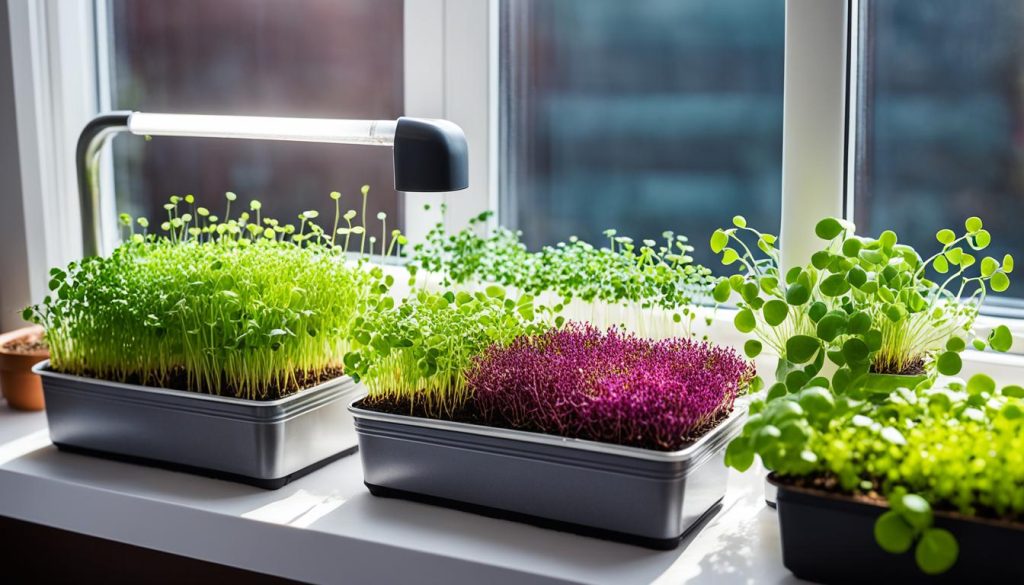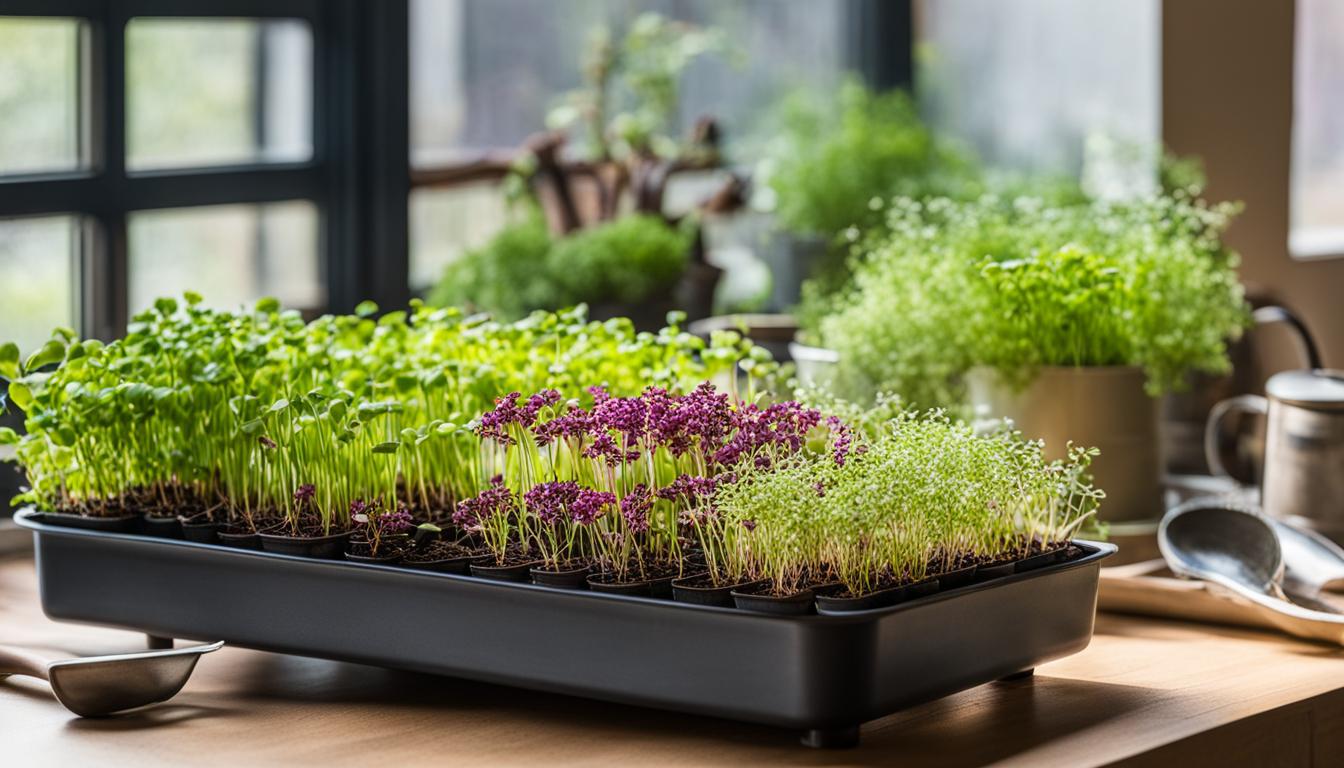Whether you’re nestled in a bustling city apartment or just keen on cultivating your culinary delights, growing microgreens indoors opens a world of freshness at your fingertips. These tiny but mighty greens are not just garnishes; they are treasure troves of nutrients packed into petite leaves. With some simple indoor gardening techniques for microgreens, you can transform your living space into a verdant paradise brimming with potential.
Not only does indoor microgreen gardening offer the joy of growing your greens, but it also serves as an introduction to gardening that requires minimal space and tools. If you’re ready to dive into the world of microgreens, follow along for some practical tips to get your indoor garden flourishing.
The Nutritional Powerhouse of Indoor Microgreens
Microgreens, the young seedlings of vegetables and herbs, have rapidly become a favorite for health enthusiasts and home gardeners alike. The reason for their popularity lies not only in their quick harvest cycle and minimal space requirements but more impressively in their dense nutritional content. Let’s delve into the compelling benefits of growing microgreens at home and how these tiny but mighty plants are making a big impact on our well-being.
Why Microgreens Are Superfoods
Attributed with astonishing levels of vital nutrients, microgreens are often deemed superfoods. They are high in vitamins, high in minerals, and high in antioxidants, each playing a crucial role in maintaining a healthy and balanced diet. Their nutrient profile is not only incredible for fostering daily health but also for arming the body with elements that have cancer-fighting properties and offering weight management benefits. This makes the choice to cultivate microgreens at home a potent step towards a more health-conscious lifestyle.
Comparing Nutrient Density: Microgreens vs Mature Plants
When set beside their mature plant counterparts, microgreens reign supreme in nutrient density. Some varieties contain up to 40 times more nutrients than fully grown vegetables. These include essential vitamins such as A, C, E, and K, besides high levels of beta carotene. A well-known supporter in the microgreen varieties, broccoli sprouts boast of sulforaphane, a powerful phytochemical known for its potential in inhibiting cancer growth and aiding in weight management. The presence of critical minerals such as potassium, iron, and zinc further cements microgreens as a nutritional powerhouse, especially enticing for those fostering a culture of wellness at home.
With every snip of these greens from your indoor garden, you invite a surge of health into your meals. By partaking in this snippet of horticulture, you’re not just garnishing your dishes but enriching your body’s own ecosystem with preventative agents against chronic diseases. This makes the commitment to grow, nurture, and harvest microgreens in the comfort of your home a deeply rewarding endeavor.
Setting Up Your Indoor Microgreen Garden
Embarking on the journey of how to grow microgreens indoors begins with gathering the essential tools and materials. Fortunately, many of these items can be found around your house or obtained with ease, setting you on the path to successful indoor microgreen growing.
An indoor microgreen garden necessitates some basic supplies. To get you started, consider the following checklist of items you’ll need:
| Supplies | Details | Notes |
|---|---|---|
| Seeds | Diverse varieties suitable for microgreen cultivation | Opt for organic and non-GMO for higher quality crops |
| Water | Reserved for soaking and watering | Use filtered water to avoid chlorine commonly found in tap water |
| Growing Medium | Peat-based mix, coconut coir, fiber mats | These are preferred mediums for efficient rooting and growth |
| Trays or Containers | Trays with drainage or repurposed food containers | Ensure containers are clean and have adequate drainage holes |
| Measuring Tools | Kitchen scale or measuring cups | For precise seed sowing and water measuring for consistent watering |
If you lack specialized equipment, everyday items like repurposed food packaging make excellent alternatives for growing trays. Simply add drainage holes to accommodate your growing microgreen needs.
While many microgreens are content with the sunlight provided by a well-positioned window, darker seasons and environments call for the assistance of artificial plant growth lighting. Incorporating these indoor microgreen growing tips can supplement natural light, ensuring your greens thrive regardless of the weather outside.
By setting a solid foundation with the right tools and environment, you’re already halfway to harvesting your very own lush, nutrient-packed microgreens from the comfort of your home.
Choosing the Right Seeds for Microgreens
Embarking on the path of how to grow microgreens indoors starts with understanding the importance of selecting quality microgreen seeds. This foundational step is pivotal for ensuring not only a bountiful crop but also one that is nutrient-dense and flavorful. Best practices for indoor microgreen cultivation revolve around knowing the specifics of each seed type, from their growing requirements to their unique flavor profile.
Top Varieties for Nutrient Density
Nutrient density is a crucial aspect when selecting microgreen seeds. Varieties such as broccoli, kale, radishes, arugula, and cilantro are lauded for their health benefits, boasting high levels of vitamins and minerals that are essential for our diet. If you’re aiming for optimal growing conditions, these varieties are resilient and adaptable to the indoor environment, making them excellent choices for gardeners of all experience levels.
Considering Germination Rates and Growth Cycles
To maintain a steady supply of these leafy greens, understanding the germination rates and growth cycles of different microgreen seeds is essential. While some seeds may require pre-soaking to hasten germination, others spread readily on the growing medium. Factors like moisture level, temperature, and light also play a significant role in ensuring successful germination and a consistent growth cycle for your greens.
It’s not just about best practices for indoor microgreen cultivation; it’s also about carefully planning your harvest schedule. By knowing the growth patterns of your chosen varieties, you can sow seeds in intervals, ensuring you have fresh microgreens ready to harvest at all times.
Armed with the right knowledge and the finest microgreen seeds, you’re well on your way to creating a lush indoor garden that provides both nourishment and aesthetic delight.
Optimal Growing Conditions for Growing Microgreens Indoors
The journey to successful indoor microgreen cultivation starts by creating an environment that closely mimics nature’s own. By paying close attention to factors such as light, moisture, and air circulation, you can create a thriving garden in even the tiniest of spaces. These elements are not just details but the very bedrock of growing microgreens in small spaces.
To kickstart your growth, both natural and artificial lighting play pivotal roles. Ideally, a south-facing window that bathes your greens in sunlight for most of the day will suffice. However, if you’re faced with limited natural light, do not fret—growth lights can compensate, providing your greens with the necessary spectrum of light for photosynthesis.
Adequate moisture is another cornerstone of healthy microgreen growth. It’s crucial to maintain a consistent level of moisture without waterlogging your medium which can lead to root rot and harmful fungal growth. A robust growth medium must ensure proper drainage while still retaining enough moisture to maintain plump, lush microgreens.
When it comes to air quality, good circulation prevents many common ailments that befall indoor plants. Stagnant, humid air can create a breeding ground for plant pathogens. Therefore, keeping the air moving around your garden is essential.
Best practices for indoor microgreen cultivation also involve regular monitoring and adjustments to keep growth conditions consistent. Change isn’t a microgreen’s best friend; they love stability. It’s not only about setting up the perfect conditions but ensuring they stay that way.
| Condition | Recommendation | Benefits |
|---|---|---|
| Light | 6-8 hours of sunlight or equivalent growth lights | Promotes vigorous and even growth |
| Moisture | Consistent soil moisture, but not saturated | Prevents root rot, supports nutrient uptake |
| Air Circulation | Use of a gentle fan or natural airflow | Reduces disease risk by keeping foliage dry |
| Temperature | Between 60-75°F (15-24°C) | Optimal germination and growth rate |
Following these guidelines will set your indoor microgreen garden on the path to thriving green abundance—where nutrient-packed leaves reach upwards, eager to be harvested. With these tips for successful indoor microgreen cultivation, even a small ledge becomes a powerhouse of vitality.
Watering Techniques for Thriving Microgreens
For enthusiasts of indoor microgreen gardening, understanding the nuances of watering can mean the difference between a flourishing crop and a withering disappointment. Watering your greens is not just about frequency; it’s about method and balance to achieve successful indoor microgreen growing. Let’s dig into the specifics that will equip you with the right skills for your green endeavor.
Understanding Soil Moisture Needs
Microgreens have delicate roots that require consistent moisture for optimal growth. The goal is to maintain even soil moisture, but this can vary depending on your indoor conditions. A reliable tactic is to observe the color and feel of the growing medium; a lighter color and dry texture indicate it’s time for water, while a darker color suggests sufficient moisture. When you’re growing microgreens indoors, it’s a fine balance that becomes intuitive over time.
Tips for Avoiding Over-Watering and Root Rot
Over-watering is a common pitfall in indoor microgreen gardening. To combat this, the practice of bottom watering is highly recommended. Here’s a simple guide to this technique:
| Step | Action | Benefit |
|---|---|---|
| 1 | Fill the bottom tray with water | Lets roots absorb moisture as needed |
| 2 | Allow the growing medium to wick up the water | Minimizes mold and fungus risk |
| 3 | Remove any excess water after a few minutes | Prevents root rot by not letting roots sit in water |
Incorporating materials like vermiculite into your growing medium can help retain moisture and release it slowly, making moisture management more forgiving. By following these tips for successful indoor microgreen cultivation, you’ll ensure your microgreens thrive without the peril of being drenched or drowned.
Growing Microgreens in Small Spaces
When space is at a premium, growing microgreens in small spaces becomes a delightful challenge met with innovative indoor gardening techniques for microgreens. Urban dwellers and those with compact living quarters can harness the robust potential of microgreens to bring abundant greenery and nutrition into their homes.
Armed with practical know-how, even the tiniest corners—be it a cozy windowsill or a sliver of countertop—can transform into a verdant microgreen mecca. The key to success lies in selecting the right varieties and employing strategic cultivation practices. For starters, here’s a compact guide on what to grow and how to maximize your available space:
| Microgreen Variety | Container Size | Light Requirements | Harvest Time |
|---|---|---|---|
| Radish | Small trays (5″x5″) | Bright, indirect sunlight | 10-12 days |
| Kale | Modular containers | Full spectrum LED lights | 5-7 days (for baby greens) |
| Arugula | Vertical planters | Filtered natural light | 7-10 days |
| Pea Shoots | Stackable trays | Fluorescent grow lights | 8-14 days |
In the realm of microgreens, finesse is achieved through vertical gardening and optimized light exposure. Not to mention, the gift of fresh, homegrown nutrients is but a few days away, with varieties like radish offering up harvests in less than two weeks! With these techniques, you can sprinkle your living space with not just greenery, but also healthy, edible plants.
Harvesting Your Indoor Microgreens
Once you’ve mastered how to grow microgreens indoors, the next exhilarating step is harvesting microgreens. This phase is both the culmination of your dedication and the gateway to savoring the fruits—or rather, greens—of your labor. Knowing when and how to harvest ensures that the nutritional value and taste are maximized for your enjoyment and health.
When to Harvest for Peak Flavor and Nutrition
The ideal time for harvesting your indoor microgreens is a delicate balance stemming from keen observation and timing. At about two to three weeks from sowing, these tiny but mighty greens will signal their readiness by unfurling their first true leaves. This stage is not merely a visual cue but a benchmark for peak flavor and nutrition. Be on the lookout for greens that stand between one to three inches tall—a sign they’re at their prime for cutting.
Best Practices for Cutting and Storing Microgreens
To reap the freshest and most flavorful microgreens, employ a sharp pair of kitchen scissors or a knife and gently snip the stems just above the soil line. This method prevents soil from sullying the greens and ensures a clean cut, paving the way for possible new growth. Post-harvest, your bountiful greens demand a cool environment and an airtight container for storage—aim for the crisp drawer of your refrigerator where they can stay fresh for up to a week. It’s all part of the best practices for indoor microgreen cultivation, so you can indulge in their goodness repeatedly. The process reflects a cycle of growth and renewal that is foundational to successful indoor microgreen growing.
Common Challenges and Solutions in Microgreen Cultivation
Despite the joy and nutritional benefits that successful indoor microgreen growing offers, certain hurdles can dampen the spirits of even the most enthusiastic cultivators. One of the most common challenges in microgreen cultivation includes mold growth, which can swiftly turn a healthy microgreen crop into a garden of concerns. However, with the right knowledge and care, these issues can be managed or even prevented.
Moisture control is paramount when it comes to preventing mold and other fungal diseases. A hygienic growing environment and vigilant monitoring can keep these pesky problems at bay. Additionally, achieving even germination can be tricky, but sowing seeds uniformly and providing suitable coverage according to each species can create the uniformity sought after by growers.
Insufficient lighting is another challenge that can hinder the growth of microgreens. The solution often lies in combining natural daylight with solutions for indoor microgreen gardening such as grow lights, which supply the essential light intensity and duration needed for steady growth. By addressing these concerns, indoor microgreen gardeners can expect a bountiful and rewarding harvest.
Remember that with the right approach, the common challenges in microgreen cultivation become mere stepping stones on the path to a thriving indoor garden. Regularly monitoring and fine-tuning the conditions in which microgreens grow not only enhances their chances of success but also ensures a fresh, nutrient-rich supply of greens right from the convenience of home.
Benefits of Growing Microgreens at Home
Embracing the practice of growing microgreens at home has surfaced as a trend not only for its culinary advantages but for the multiple layers of wellness it contributes to. The inclusion of these tiny, yet mighty greens into one’s diet and daily routine can lead to significant positive impacts on both physical and mental health.
Health Benefits of Regular Consumption
Microgreens, with their dense nutritional profile, pack a punch when incorporated into a healthy diet. Regular consumption of these greens brims with health benefits, as they are abundant in vitamins, minerals, and antioxidants. These nutrients are essential in supporting the immune system, reducing inflammation, and promoting overall well-being. The practice of incorporating microgreens can be a game-changer for those looking to enhance their dietary intake with nutrient-rich foods.
The Psychological Rewards of Indoor Gardening
There’s an inherent tranquility to indoor gardening, and when microgreens enter the picture, the psychological rewards are especially gratifying. The satisfaction of sowing, nurturing, and watching your greens grow cultivates a sense of accomplishment and provides therapeutic stress relief. This connection with nature, on a miniature scale, can be a serene counterbalance to the hectic pace of modern life, delivering significant psychological rewards.
Indoor Gardening Techniques for Microgreens
Indoor gardening techniques for microgreens are not just a trend, they are becoming an essential part of urban food production. With a little know-how, you can transform your home into a bountiful garden. Optimal lighting is the cornerstone of plant growth, particularly for microgreens that thrive under the right intensity and duration of light. Whether it’s a sunny windowsill or a setup with grow lights, ensuring your plants have enough light will drive their photosynthesis and growth.
To achieve successful indoor microgreen cultivation, paying attention to the uniformity of seed sowing is crucial. It helps in even growth and reduces the competition among seedlings for light and nutrients. Proper hydration through techniques such as bottom watering or misting is equally vital. These methods restrict mold growth and ensure seeds receive moisture without becoming overly saturated.
Microgreens are forgiving plants; they can grow in a variety of containers and don’t need a lot of room. They’re perfect for small spaces, which is great for city dwellers or those without garden space. Moreover, good air circulation around your plants will keep them healthy and reduce the risk of pests and diseases.
| Technique | Purpose | How to Implement |
|---|---|---|
| Optimal Lighting | Supports photosynthesis and growth | Position near a sunny window or use LED grow lights |
| Uniform Seed Sowing | Ensures even growth and reduces overcrowding | Spread seeds evenly across the growing medium surface |
| Bottom Watering/Misting | Maintains moisture without over-watering | Add water to the tray beneath pots or mist lightly |
| Air Circulation | Prevents disease and encourages strong stems | Use a fan or ensure space between plants for natural airflow |

Remember, each microgreen type may come with its own set of nuances, so keeping detailed notes on what works best for each variety can help refine your techniques. With these tips and a bit of patience, you’ll be on your way to harvesting your lush, tasty microgreens right from your indoor garden.
Conclusion
Embarking on the journey to grow microgreens indoors places a wealth of nutritional richness at your fingertips. This guide has provided an integral pathway towards establishing a verdant oasis within your home and has equipped aspiring gardeners with key principles for successful indoor microgreen growing. By adhering to a few fundamental guidelines—procuring superior seeds, ensuring ample lighting, and vigilantly managing moisture—your venture into the fertile world of microgreens is poised for success. With every harvest, these miniature greens contribute a burst of flavor and concentrated nutrients to your diet, reinforcing the well-being of both your body and palate.
Summary of Indoor Microgreen Growth Tips
The culmination of growing microgreens hinges upon a fine balance of conditions and care. Regular observations and adjustments will seamlessly become part of your routine, fostering a harvest that boasts the utmost in taste and vitality. Whether you’ve selected broccoli, radish, or any of the plethora of varieties, the freshness of your own microgreens will surpass that of any found at the market. Remember, the rewards of your perseverance in addressing common horticultural challenges are multifold—your dedication manifests in the lush, flavorful sprouts adorning your dishes.
Encouragement to Begin Your Microgreen Journey
If your curiosity about urban agriculture has been piqued, let this be your clarion call to start indoor microgreen gardening. As you delve into this craft, you will find that it’s more than just sowing and reaping—it’s a meditative act that roots you in the present and contributes to a sustainable way of life. There’s a kinship formed with each green shoot that unfurls under your care, a quiet satisfaction in watching the cycle of growth unfold on your windowsill, and ultimately, the pleasure of taste. So, why wait? Grasp a handful of seeds and let them be the first step on your path to green prosperity and overall well-being.


